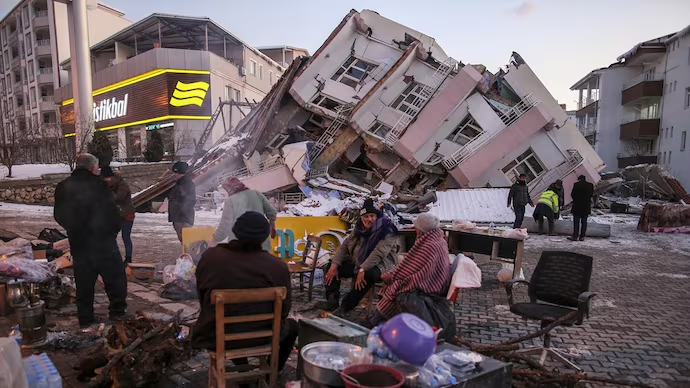
On July 29, 2025, at 23:24 PETT (11:24 UTC), a massive magnitude 8.8 earthquake struck off the eastern coast of Russia’s Kamchatka Peninsula. The tremor registered at a shallow depth of approximately 19–21 km, significantly amplifying its impact Artemis+8Wikipedia+8ndtv.com+8aljazeera.com+7cntraveler.com+7wsj.com+7.
Seismologists noted the earthquake occurred along the Kuril–Kamchatka subduction zone, where the Pacific Plate dives beneath the Okhotsk Plate—an area renowned for producing megathrust earthquakes washingtonpost.com+3Wikipedia+3southpasadenan.com+3.
A series of foreshocks, including a magnitude 7.4 on July 20, preceded the mainshock and likely released tension along adjacent segments of the fault washingtonpost.com+1southpasadenan.com+1.
🌀 Tsunami Alerts Across the Pacific
The undersea displacement triggered tsunami watches and warnings stretching from Russia to Japan, Hawaiʻi, Alaska, and the U.S. West Coast:
- In Russia, coastal areas experienced waves over 10 ft, flooding parts of Severo‑Kurilsk. Authorities declared a state of emergency and evacuated residents from low-lying zones washingtonpost.com+3news.com.au+3nypost.com+3thesun.co.uk+4Axios+4news.com.au+4.
- Hawaiʻi recorded waves up to 5–6 ft (1.5–1.8 m). Initially under a tsunami warning, the alert was downgraded to an advisory by morning as risk assessments improved people.comyahoo.comcntraveler.comindiatimes.comyahoo.com.
- Along the California, Oregon, and Washington coasts, advisories and warnings remained active, particularly in Humboldt and Del Norte counties. Waves of 1–4 ft were observed in places like Arena Cove Axios+1people.com+1.
- In Japan, waves reached up to 2 ft on Hokkaido’s coast. Although evacuations were ordered, no major destruction occurred, and nuclear plants remained safe Artemis+1indiatimes.com+1.
📉 Impacts & Aftershocks
- Though no fatalities have been confirmed, infrastructure in Severo‑Kurilsk was damaged—schools and harbors flooded—and aftershocks of magnitude 5.0+ continued news.com.au.
- Comparisons are already being drawn to the devastating 1952 megathrust earthquake (magnitude 9.0) in the same region, which triggered a tsunami that killed over 2,300 people locally and generated 6 m waves that traveled as far as Hawaiʻi and Peru WikipediaWikipediaWikipedia.
🚨 Expert Commentary & Guidance
- U.S. authorities emphasized that initial waves may not be the largest and urged continued evacuation vigilance—especially along higher-risk coastal areas Axios.
- Pacific-wide tsunami alerts were issued but were gradually scaled down as ocean buoy data showed minimal risk beyond local fluctuations indiatimes.com.
📌 Summary Table
| Key Element | Details |
|---|---|
| Magnitude & Depth | 8.8 MW, ~19–21 km deep |
| Epicenter Location | ~119 km east‑southeast of Petropavlovsk‑Kamchatsky |
| Affected Regions | Russia (Kamchatka), Hawaiʻi, Alaska, U.S. West Coast, Japan |
| Max Wave Heights | Russia: ~10 ft; Hawaiʻi: ~5–6 ft; U.S. West Coast: 1–4 ft; Japan: ~2 ft |
| Aftershock Activity | Multiple quakes ≥ 5.0; a 7.4 foreshock occurred on July 20 |
| Historical Comparison | Most powerful since 1952 Kamchatka M9.0 earthquake with catastrophic tsunami |
✅ Key Takeaways
- This temblor ranks as one of the largest earthquakes in recent decades, making it the sixth-largest ever recorded, comparable to notable events in Kamchatka’s seismic history rnz.co.nz+8washingtonpost.com+8earthquakelist.org+8.
- While early tsunami waves affected multiple Pacific coastlines, no major casualties have been reported thanks to timely evacuations and rapid response efforts.
- Aftershocks remain a concern, and local authorities continue monitoring for potential secondary tremors and sea-level changes.
🧭 Key Takeaways
- The 8.8 magnitude quake is one of the largest recorded in decades, generating tsunami alerts across an unprecedented expanse of the Pacific ocean ft.com+1The Sun+1Al Jazeera+5AP News+5ft.com+5.
- Damage in Russia was the most substantial; globally, the impact was mitigated by quick response and effective early warnings.
- Continuing aftershocks and tsunami monitoring remain crucial, especially for coastal communities across the Pacific cadenaser.comScientific American.